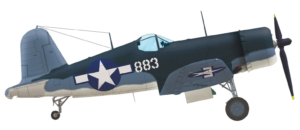
Pappy Boyington
Gregory “Pappy” Boyington was an extraordinary figure whose life encompassed his heroics in World War II, his renowned fighter plane, and his later fame as the inspiration behind a popular television series. This article aims to shed light on the remarkable achievements and experiences of Pappy Boyington, focusing on three key aspects: his life in the war, his airplane, and the television series that immortalized his legacy.
- Pappy Boyington: A Heroic Life in the War: Pappy Boyington’s journey in the war was characterized by bravery, tenacity, and exceptional flying skills. As a Marine Corps aviator, Boyington achieved fame as the commanding officer of the legendary “Black Sheep Squadron” or VMF-214, a group of elite fighter pilots. He participated in the Pacific theater, engaging in dogfights with the Japanese and playing a vital role in pivotal battles such as the defense of Guadalcanal. Boyington’s combat prowess earned him the Medal of Honor, making him one of the most decorated American pilots of World War II. His leadership and strategic acumen were instrumental in shaping the course of the war in the Pacific.
- The F4U Corsair: Pappy Boyington’s Iconic Airplane: Central to Pappy Boyington’s success in the war was his airplane, the Vought F4U Corsair. The Corsair, renowned for its distinctive gull-wing design, was a formidable fighter aircraft. Boyington’s preference for the Corsair stemmed from its exceptional speed, agility, and firepower. It became the signature plane of the Black Sheep Squadron, aiding them in achieving aerial dominance against their adversaries. Boyington’s mastery of the Corsair and his ability to maximize its capabilities solidified his status as an ace pilot and furthered the aircraft’s reputation as an iconic symbol of American military aviation.

- The Television Series: Bringing Pappy Boyington’s Story to the Masses: Pappy Boyington’s remarkable wartime experiences were brought to the forefront of popular culture through the television series “Baa Baa Black Sheep,” later renamed “Black Sheep Squadron.” Running from 1976 to 1978, the series was inspired by Boyington’s autobiography and aimed to portray the exhilarating adventures of the Black Sheep Squadron. Robert Conrad portrayed Boyington in the show, capturing his charisma and larger-than-life personality. The series resonated with audiences, showcasing the valor and camaraderie of the pilots while shedding light on the challenges they faced during the war. Although it took creative liberties with certain aspects, the show played a significant role in raising awareness of Pappy Boyington’s wartime achievements and immortalizing his legacy for generations to come.
Conclusion: Gregory “Pappy” Boyington’s life in the war, his iconic airplane, and the television series based on his experiences are all testaments to his indomitable spirit and lasting impact. As a heroic fighter pilot, Boyington’s contributions to the war effort were exceptional, earning him admiration and respect from his comrades and the nation. His Corsair fighter plane became synonymous with his legacy and remains an enduring symbol of American aviation history. The television series “Black Sheep Squadron” introduced Pappy Boyington’s remarkable story to a wider audience, ensuring that his bravery and leadership would continue to inspire future generations. Gregory “Pappy” Boyington’s extraordinary life will forever be remembered as a testament to the courage and dedication of those who served their country during World War II.
